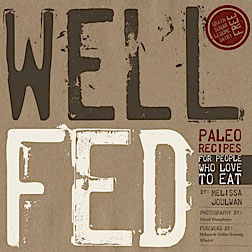I really wanted a cute name for these meatballs. I tried for, like, 10 minutes to come up with a workable play on caraway seeds....
Read MorePork Schnitzel Patties with Cauliflower Purée (Paleo, Whole30)
In each issue of Paleo Magazine, I team up with Steph Gaudreau to share the history of a traditional recipe and adapt it to fit into a healthier paleo lifestyle. (I write the words; she makes the gorgeous photos.) This time, we went on a culinary tour of my adopted home in Prague, Czechia.
Since adventurers and tourists began flocking to the Czech Republic in the late 1990s, Czech food has had a reputation for heavy, meat-centric meals that lacked both vegetables and spices. I’m happy to report that now vibrant salads and fresh soups can be found in most Czech restaurants. In Prague, it’s fairly typical to see a Thai restaurant, French café, vegan eatery, burger joint, kebab stand, and a Czech pub all on the same block. And though the international restaurant scene is thriving, the traditional Czech foods—schnitzel, dumplings, sausages, breads and cakes—are also still very common. Czech cuisine reflects the influences of its neighboring countries, all former members of the Austro-Hungarian Empire which was in power from roughly the mid-1800s through the beginning of World War I.
Praise the lard!
Pork is the most common meat in the Czech Republic—more than half of the meat consumed is from a hog. The most popular ways to eat it are sausages (klobásy), roasted pork knuckle, tenderloin (often stuffed with prunes), a luscious spread made from lard and pork cracklings (škvarková pomazánka), and schnitzel. Ah, schnitzel.
Known in Czech as řízek, the schnitzel in Czech restaurants and pubs is usually made from pork or chicken breast that’s been pounded thin, dunked in beaten egg and breadcrumbs, then pan-fried on both sides until crisp. You’re probably already familiar with Wienerschnitzel, a traditional Austrian dish made from veal (and which, by law, must be made from veal in Austria). It was the favorite dish of Emporer Franz Joseph of Austria-Hungary, ruler of the Austro-Hungarian empire from 1867 to 1916.
The genius idea of preparing meat this way—pounding it to make it tender before coating in something that turns crunchy when it’s fried—actually originated in Italy. Legend has it that an Austro-Hungarian General (of Czech descent), General Ratezky, enjoyed many plates of the Italian dish Cotoletta alla Milanese in Milan. A short time later, when he returned to Austria, Wienerschnitzel appeared on menus shortly thereafter. Culinary coincidence or appetite appropriation?
Now variations of schnitzel can be found around the globe. In Latin American countries, it’s often prepared with beef and is known as milanesa. The Indian version is known as kabob; the meat is pounded, coated in flour and Indian masala, then pan-seared. Japanese tonkatsu uses tender pork loin and replaces flour with panko crumbs. Schnitzel has even made its way across the Atlantic to the United States, in the form of chicken fried steak. In the mid-19th century, German and Czech immigrants settled in Texas, bringing their traditional pastries (kolaches) and schnitzel recipes with them. Beef was far more plentiful in the North America than pork, so they pounded tough cuts of beef into submission. One day, a cook accidentally reached for a steak schnitzel when he should have been preparing fried chicken, and chicken-fried steak was born.
Here in Prague, I’ve been known to dig into a giant pork schnitzel on special occasions. One day, lunch at our neighborhood pub—U Tří Bojovníků—gave me a deliciously good idea. The pub’s regular menu includes both pork and chicken schnitzel, but sometimes the daily special is a juicy ground pork patty, lightly breaded and pan-sautéed until it’s very crispy. It’s usually served on a bed of creamy mashed potatoes. This is the stuff of which paleo makeover dreams are made.
My updated version of their schnitzel patty keeps the ground pork, but replaces the flour breading with a light coat of crushed pork rinds, and these patties are baked in the oven to make the cooking and clean-up process far easier. While the schnitzel bakes, you can whip up the accompanying cauliflower purée. It’s lower carb and packs more vitamins and minerals than mashed potatoes, although you could substitute potato mash or boiled potatoes instead to be more of a traditionalist.

Pork Schnitzel Patties with Cauliflower Purée
Serves 2-4 | Prep 10 minutes | Cook 25 minutes | Whole30 compliant
Ingredients:
Schnitzel Patties:
1 1/2 pounds ground pork
1 teaspoon salt
1/2 teaspoon ground black pepper
1 tablespoon lemon juice
1/2 cup fresh parsley, minced
1 large egg
3 ounces pork rinds, crushed
garnish: lemon wedges, fresh parsley
Cauliflower Purée:
1 head fresh cauliflower, broken into florets
1 garlic clove, crushed (about 1 teaspoon)
4 teaspoons coconut oil or pastured lard
1/2 cup canned, unsweetened coconut milk
1/4 teaspoon salt
1/8 teaspoon ground black pepper
2 tablespoons dried chives
Directions:
Preheat the oven to 425F and line a large, rimmed baking sheet with aluminum foil (for easy clean up).
Season the meat. In a large bowl, combine the ground pork, salt, black pepper, lemon juice, and parsley. Mix all the ingredients with your hands until combined.
Shape and cook the patties. Beat the egg in a shallow bowl and place pork dust in another shallow bowl. Shape the pork into 4 equal-sized patties; dip each patty in the beaten egg, then in the crushed pork rinds until they’re coated. Place on the baking sheet and roast in the oven until sizzling and crisp, 20–25 minutes. Meanwhile…
Cook the cauliflower. Place 1/4 cup water in a medium saucepan, bring to a boil, add the cauliflower, and cover. Return to a boil and steam the cauliflower until it’s very tender, 7-10 minutes. Drain off any remaining water and add the garlic, coconut oil or lard, coconut milk, salt, pepper, and chives. Cover and heat 5 minutes, then purée with a stick blender (or transfer to a food processor and purée.)
To serve, place a schnitzel patty on a bed of cauliflower purée and sprinkle both with minced parsley and a squeeze of lemon juice.
You Know How You Could Do That?
Replace the ground pork with ground chicken (for chicken schnitzel) or ground beef (for minced chicken-fried steak)
Add a side of Kickin’ Cranberry Sauce. Cranberries are frequently served alongside schnitzel here in Prague.
Still hungry? Try these
As I mentioned in this post from back in May, I ate a lot (A LOT!) of the skinless Balkan sausages called ćevapčići while we...
Read More




Not only does this look incredibly delicious, I have another reason to make this dish: my paternal grandparents were born and raised in Galicia in what was then the Austro-Hungarian Empire, and they immigrated to the US together sometime around WWI, exact date unknown. I’ve never had Schnitzel, but I have a great local source of organic pastured veal, so I could make these with ground veal if you think that would be good too?
(BTW, I love, love, love the way that it is so easy to print recipes from your website — your print formatting is so succinct and efficient and only uses 1 printed page — it’s just a little thing, but I appreciate that very much!!!)
It’s always really fun to find a family connection to a particular recipe. You should definitely try this one! And yes, if you want to try veal, ground veal would work great.
Thank you for the kind words about our printable recipes. I’m glad they’re helpful!
hmm. So pork rinds are whole 30? or at least can be? I’ve never had them in my life, believe it or not; I guess I will have to try this recipe. And for the record, I made Mel’s mashed cauliflower for Thanksgiving this year, and it was a pretty big hit.
Yes, pork rinds are approved for Whole30. 🙂
Love reading your posts! I’m gathering the ingredients to make this dish (looks yummmy, delish), but I’m looking for egg replacements. Yeah, I can buy the stuff at the store, but am wondering if you’ve come up with good options. I’m no dairy, no gluten, no soy, no egg yolks. Should I just whip up with egg whites?
You can either use egg whites only (which should work pretty well), or skip the binder completely and just pat the outside of the patties with the “breading.” You’ll get more of a coating with the egg whites, but it will work to some extent without, too. Let me know how it goes!